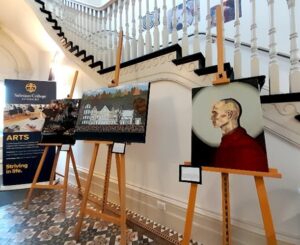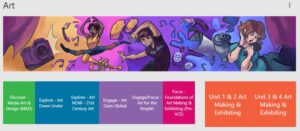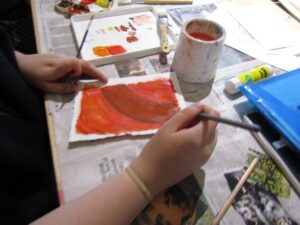How many Art Teachers does it take to change a Curriculum?
Glenda Inglis-Gillespie
Abstract: It sounds like this question should have a punch line, doesn’t it? OK, let’s re-phrase the question as an open-ended inquiry. What about, “How can a small team of Visual Art teachers re-design all our Art subjects at Years 7 to 10 to deliver engaging, student focused project based inquiry learning in response to a whole school move to Vertical Curriculum?” Our journey at Salesian College Sunbury is one possible response.
~~~~~~~~~~~~~~~~~~~~~~~~~~~~~~~~~~~~~~~~~~~~~~~~~~~~~~~~~~~~~~~~~~
We knew the change was inevitable, a whole school move to a “stage not age” curriculum for Year 7-10. A move to a focus on deeper learning principles, ensuring our 7-9 subjects used Project Based Learning and our Year 10 subjects had clear links to VCE opportunities. For the Visual Arts, this provided scope to home in on what we want our students to learn how to do, and to ensure growth in their artistic development, sensibilities, and experiences. It also provided opportunity to shine a light on Visual Arts in the college (Figure 1) “A hallmark of deeper learning is students’ ability to apply their knowledge to new situations and complex problems like those they will experience outside school. Enacted through project-based learning… these deeper learning approaches help students learn to think critically, collaborate, and communicate within and across disciplines, while they “learn how to learn” and develop mindsets that increase perseverance and productive learning behaviours.” (Hernandez et. Al. 2019)
While it sounded both exciting and daunting, focusing on Art as a continuum as outlined in the Victorian Curriculum is, “structured as a continuum across levels of learning achievement not years of schooling. This enables the development of targeted learning programs for all students.” (VCAA Victorian Curriculum overview)

Fig. 1 Gallery space below one of our Art Rooms with VCE work on display 2023
Through discussion amongst Curriculum Leaders and all staff facilitated by our Directors of Curriculum and Staff Learning, a project planner was developed to meet the specific needs of our college to scaffold the process of developing each project (using New Tech Network as our model). Each planner outlined the project scenario, curriculum links, driving question, entry event, benchmarks, literacy & numeracy links and evidence of student agency, collaboration, and critical thinking, as well as scope and sequence. Substantial documentation!
As the Curriculum Leader of the Visual and Performing Arts, I had the opportunity to both lead and support the Art teaching team through the process, along with a small team of Music, Dance, Drama, Media and Visual Communication Design staff. The team of Visual Art teachers working on this project included myself, two full time teachers (one experienced, the other with one year experience teaching Art) and two part time teachers. I was also incredibly fortunate to work with a passionate and focused team of Curriculum Leaders who were sharing this journey in their respective subject areas. This also allowed for creativity and rich cross curriculum conversations, as well as shared experiences of challenges as we faced them.
At the heart of the changes was the student experience and desire to increase student engagement. That is where we could begin our process, it gave us a hook to leverage our student experience of the Arts and ensure that Art was exciting, engaging, and developed skills and placed Arts education on the continuum into life beyond secondary school. Research indicates that PBL clearly benefits middle school students of Visual Art, ‘students structured information meaningfully and learned in depth in the visual arts … and they achieved high gains and positive attitudes’ (Ozkan, 2023, p377)
We were confident that the very nature of art making placed us ahead of the game in terms of writing PBL curriculum. Art is at once authentic and intrinsically belongs to the individual, and our students aren’t dictated to about what the product needs to be or look like, the desired learning outcomes are the skills and knowledge, not the product itself. Creating an artwork and working in a visual journal is not dissimilar to project-based learning, but this was our opportunity to provide key learning moments, workshops, skills development alongside concept building, collaborative inquiry, curiosity, creative and critical thinking, and authentic personal interests.
We undertook curriculum mapping to discover gaps, overlaps and opportunities.
We were able to “re-jig” some of our existing subjects with new projects, for example 21st Century Art became “The Art of NOW” with one project investigating contemporary art and artists, and the other, “I am a Contemporary Artist” allowing students to experience workshops, to experiment, to work with others and to create using technology or traditional artforms.

Fig. 2 – Subject outline for the project ‘I am a Contemporary Artist’
This was a great opportunity to propose new subjects in the Arts, based on student voice and cross-curriculum opportunities. One new Visual Art subject is “Art for the People”, explorations in public art, community art, sculpture and installation, culminating in a site-specific collaborative artwork focusing on an issue of choice that resonates with our young people. Students will document audience participation and experiences of the work as part of their learning journey. This subject was primarily proposed and written by one of our passionate part time Art teachers who holds a joint position of responsibility as our Community Engagement Co-ordinator – who better to engage our students with real world connections between art and audience, and art and the wider community or industry networks?
Our 7-10 Visual Art subjects for 2024 move through a continuum from Discovery to Focus, they are: “Media, Art & Design” – an introduction to visual storytelling through different art forms; “Art NOW” – exploring contemporary art; “Art Down Under” – exploring Australian Art, drawing, mixed media and response to artists as influence, “Art Goes Global” – projects with total freedom of art form and mediums, in response to artworks, art movements and artists from around the world, “Art for the People”, and “Foundations of Art Making and Exhibiting” our pre-VCE Art subject that develops a concept of personal style, response to artists of influence and the art making process and understandings of audience, curating and exhibition concepts

Fig 3. Student view of our Art subject offerings on our LMS (including our visual banner, made by student Kayley Irvine – we held a competition open to all students for our banner, in keeping with a student-centred approach.
I am immensely proud of all our Arts teachers and the incredible work they have put in to ensure our Arts projects are student centred and a joy to teach, and we can’t wait to see what our students make in response!
Students are enrolled and already we are seeing the stage not age choices, with mixed year levels. Students are choosing by interest and passions, and we are hopeful that our developmental rubrics will prove useful in assessing students based on what they can do, on where they are at, and how they grow in the Arts Capabilities over time.
In 12 months, we have proposed new subjects, written project planners for all projects, created and resourced our projects on our LMS, and re-designed our rubrics to ensure they meet the needs of a vertical structure. A huge undertaking!
We experienced numerous challenges and roadblocks along the way, including feeling overwhelmed, stretched for time, feelings of inequity in workload. However, these proved essential for perhaps our biggest learnings about our capabilities, priorities, and commitment to our team and for our sense of achievement. Challenges are indeed what an authentic project might look like for our students, “projects provide an opportunity for students to explore, experiment, and push boundaries. Students should have the opportunity to try things their own way, and experience failure. This is considered essential in learning to learn” (Major and Govers, 2014, p11). As with all project-based learning, reflection forms an important part of the learning process, and as we embark on teaching the projects, observing student learning, and delighting in their creative responses, we will also ensure that we regularly reflect and review their impact on student engagement and growth along their Art education continuum.
So, perhaps the important question isn’t how many Art teachers it takes to change the curriculum, or even how they can change the curriculum, it’s “what can art teachers bring to create a vibrant, engaging, and relevant Art Curriculum for the 21st Century?” The answer can only be found in the process, the learnings we made along the way were as rich, complex, and valuable as those we hope for our students. We discovered creative and innovative thinking, collaborative skills, and a chance to use our individual strengths and passions.

Figure 4. Student working on an art exploration
We also brought incredible perseverance and resilience and pride in our individual and collective achievements. Above all, we brought a steadfast focus on our student experience of Visual Art, on connecting 7-10 Victorian Curriculum to learning opportunities through the experiences they provide.
~~~~~~~~~~~~~~~~~~~~~~~~~~~~~~~~~~~~~~~~~~~~~~~~~~~~~~~~~~~~~~~~~~
Citations:
Hernández, L. E., Darling-Hammond, L., Adams, J., & Bradley, K. (with Duncan Grand, D., Roc, M., & Ross, P.). (2019). Deeper learning networks: Taking student-centered learning and equity to scale. Palo Alto, CA: Learning Policy Institute.
Major, Dr S & Govers, Dr E. (September 2014) Project-based learning in visual arts and design: What makes it work? Eastern Institute of Technology & Govers Educational Consultancy and Research, Ako Atotearoa publication, NZ
New Tech Network, The Comprehensive Guide to Project-Based Learning: Empowering Student Choice through an Effective Teaching Method https://newtechnetwork.org/resources/what-is-pbl/ (accessed 12/12/2023)
Ozkan, Z. C., (2023). The effect of project-based learning in visual arts lesson on lesson outcomes and attitudes. International Journal on Social and Education Sciences (IJonSES), 5(2), 367-380. https://doi.org/10.46328/ijonses.565 (accessed 01/01/2024)
Victorian Curriculum and Assessment Authority, The Victorian Curriculum Overview, Standards and Levels, https://victoriancurriculum.vcaa.vic.edu.au/overview/curriculum-design/standards-and-levels (accessed 18/12/23)
~~~~~~~~~~~~~~~~~~~~~~~~~~~~~~~~~~~~~~~~~~~~~~~~~~~~~~~~~~~~~~~~~~
Biography:
Glenda Inglis-Gillespie is Curriculum Leader – Arts at Salesian College Sunbury. Primary and Secondary trained, Glenda teaches 7-12 Visual Art and Visual Communication Design and has been teaching at Salesian for over 12 years. Glenda has a BA (hons) in Art History, MA in Museum Studies and Material Culture, and Bachelor of Primary and Secondary Teaching. She has previously worked as Research Fellow at Deakin University exploring cultural capital of the Arts to a Regional city. Glenda is an artist and educator, passionate about providing a safe place for students to explore their creativity and developing curriculum that is meaningful and engaging to our young people.
MOST RECENT ARTicles :
Teaching Art is Easy
MAX DARBY
Sadly, for many of us, some people seem to think teaching a...
Learn more
Mornington Island Enterprise Art Project
BEN LANDERS
As a non-Indigenous art teacher with experience working in re...
Learn more
Robbie Rowlands
STUART KOOP
Seeing a body with holes, the incision so precise, the remova...
Learn more







